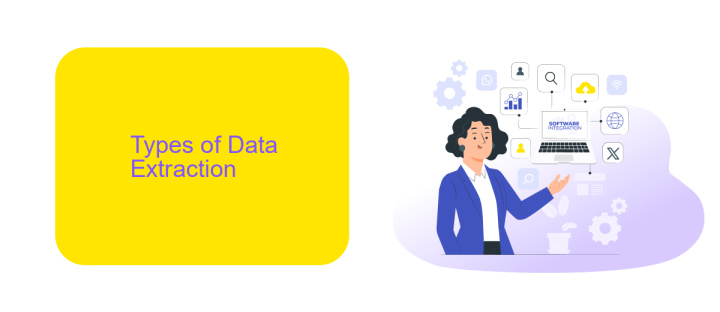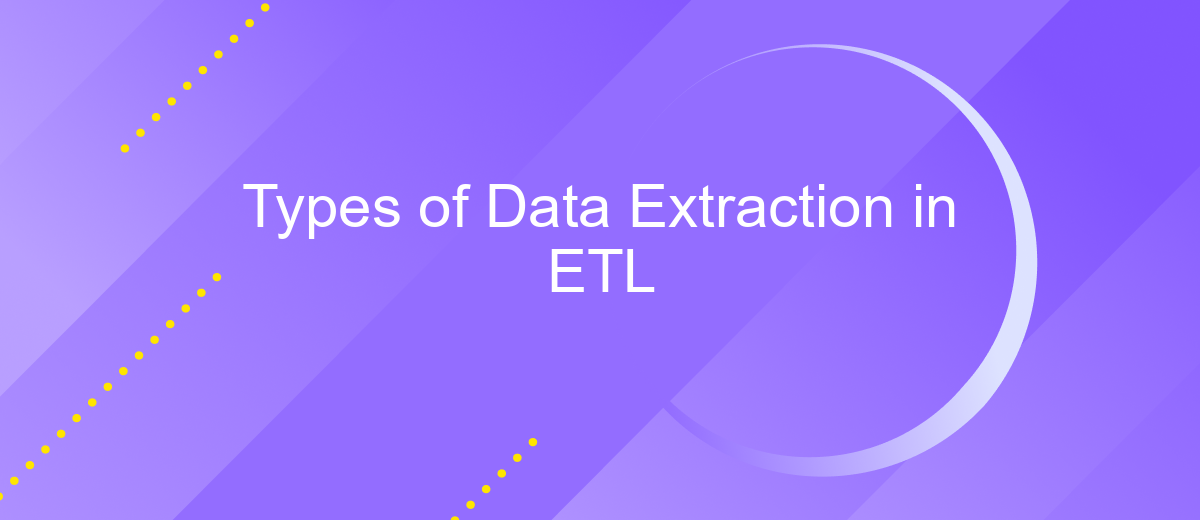Types of Data Extraction in ETL
Data extraction is a crucial step in the ETL (Extract, Transform, Load) process, which involves retrieving data from various sources for further processing and analysis. Understanding the different types of data extraction methods is essential for optimizing data workflows and ensuring data integrity. This article explores the primary techniques used in ETL to extract data efficiently and accurately.
Introduction to Data Extraction in ETL
Data extraction is a crucial step in the ETL (Extract, Transform, Load) process, where raw data is collected from various sources to be processed and analyzed. This step ensures that data is accurately gathered for subsequent transformation and loading into a data warehouse or other storage solutions.
- Structured Data Sources: Databases, spreadsheets, and other tabulated data formats.
- Semi-Structured Data Sources: XML files, JSON files, and other data formats that do not fit neatly into tables.
- Unstructured Data Sources: Text files, multimedia files, and other data formats that lack a predefined structure.
Effective data extraction often requires the use of specialized tools and services. ApiX-Drive, for example, offers seamless integration capabilities that help automate the data extraction process from various sources, ensuring high accuracy and efficiency. By leveraging such tools, organizations can streamline their ETL workflows and focus on deriving valuable insights from their data.
Types of Data Extraction

Data extraction in ETL (Extract, Transform, Load) processes can be categorized into three main types: full extraction, incremental extraction, and real-time extraction. Full extraction involves retrieving all data from the source system every time the extraction process runs. This method is straightforward but can be resource-intensive, especially with large datasets. Incremental extraction, on the other hand, only retrieves data that has changed since the last extraction. This approach is more efficient, reducing the load on both the source system and the ETL process.
Real-time extraction, also known as streaming extraction, continuously captures and processes data as it is generated. This type of extraction is crucial for applications that require up-to-the-minute information. Setting up real-time extraction can be complex, but tools like ApiX-Drive simplify the process by providing seamless integration capabilities. ApiX-Drive allows users to connect various data sources and automate the extraction process, ensuring that data is always current and readily available for analysis.
Flat File Extraction

Flat file extraction is a method used in ETL (Extract, Transform, Load) processes to retrieve data stored in flat files, such as CSV, TXT, or XML files. This approach is beneficial due to its simplicity and compatibility with various systems, making it a popular choice for data integration tasks.
- Identify the source flat file and its format (e.g., CSV, TXT, XML).
- Read the file using appropriate software or scripts (e.g., Python, SQL).
- Parse the data to extract relevant information.
- Validate the extracted data to ensure its accuracy and completeness.
- Load the validated data into the target system or database.
Tools like ApiX-Drive can simplify the flat file extraction process by automating the integration and data transfer between various platforms. By configuring ApiX-Drive, users can schedule regular data extractions, reducing manual effort and minimizing errors. This results in a more efficient and reliable ETL workflow, ensuring that data is consistently up-to-date and readily available for analysis.
Database Extraction

Database extraction is a fundamental step in the ETL (Extract, Transform, Load) process, where data is retrieved from various databases. This step involves connecting to the source database, executing SQL queries, and fetching the required data. The efficiency of this process is crucial as it directly impacts the performance and accuracy of subsequent ETL stages.
There are several methods of database extraction, each with its own advantages and use cases. These methods can be broadly classified based on how the data is accessed and retrieved. Choosing the right method depends on factors like data volume, frequency of extraction, and the specific requirements of the ETL process.
- Full Extraction: The entire dataset is extracted from the source database.
- Incremental Extraction: Only data that has changed since the last extraction is retrieved.
- Log-Based Extraction: Changes are captured by reading the database logs.
Tools like ApiX-Drive can simplify the database extraction process by providing seamless integration capabilities. With ApiX-Drive, you can easily configure and automate data extraction from various databases, ensuring that your ETL pipeline remains efficient and reliable.
API and Web Service Extraction
API and web service extraction involves retrieving data from various online sources through their respective APIs (Application Programming Interfaces) or web services. This method is particularly useful for accessing real-time data and integrating it into ETL (Extract, Transform, Load) processes. APIs provide a structured way to access data, ensuring that the information is up-to-date and consistent. Web services, on the other hand, enable interaction between different systems over a network, often using protocols like HTTP, SOAP, or REST.
One effective tool for setting up these integrations is ApiX-Drive. This service simplifies the process of connecting different applications and automating data workflows without requiring extensive coding knowledge. By using ApiX-Drive, organizations can streamline their ETL processes, ensuring seamless data extraction from various APIs and web services. This not only saves time but also reduces the risk of errors associated with manual data handling. Overall, API and web service extraction is a critical component of modern ETL strategies, enabling efficient and reliable data integration.
FAQ
What are the common methods of data extraction in ETL?
How does full extraction work?
What is incremental extraction in ETL?
How can real-time data extraction be implemented in ETL processes?
What tools can help automate data extraction in ETL processes?
Apix-Drive is a simple and efficient system connector that will help you automate routine tasks and optimize business processes. You can save time and money, direct these resources to more important purposes. Test ApiX-Drive and make sure that this tool will relieve your employees and after 5 minutes of settings your business will start working faster.

